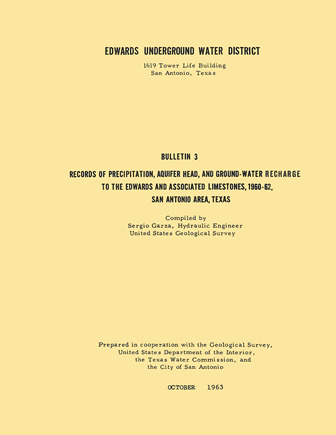Records of Precipitation, Aquifer Head, and Ground-Water Recharge to the Edwards and Associated Limestones, 1960-62, San Antonio Area, Texas

| Author | Garza S (US Geological Survey) |
| Year | 1963 |
| Description | Annual report for 1960-62 on precipitation, aquifer levels, and recharge to the Edwards Aquifer issued by the Edwards Underground Water District |
| Report Number | Bulletin 3 |
| Publisher | Edwards Underground Water District |
| Location | Edwards Aquifer Balcones Fault Zone San Antonio Segment |
| Cover | View Download |
| File | View Download |
| Summary |
|
Records of precipitation in the San Antonio area and water level data of the Edwards and associated limestones, the principal aquifer in the area, have been gathered for many years and incorporated in many geologic and hydrologic reports. The recent reports by Petitt and George (1956) and Garza (1962), which summarize all data through 1959, also include estimates of ground-water recharge. The collection of these records is part of the hydrologic investigation being made by the U. S. Geological Survey in cooperation with the Edwards Underground Water District, the Texas Water Commission, and the city of San Antonio. Records of annual precipitation at selected stations throughout the San Antonio area for the period 1960-62 are shown in table 1. Also included is the annual average for each of the stations. Rainfall during 1960 and 1961 generally was near the average throughout the San Antonio area. The annual rainfall in most of the area was below average in 1962, the first year of area-wide deficiency since the end of the recent drought of 1947-57. Table 2 shows the annual recorded high and low- water levels in five key wells in the San Antonio area for the period 1960-62; the record high and record low for each well are shown also . Water levels in many wells were record highs in 1961 : the last year of above-average rainfall during the period 1957-62. The record lows occurred during the peak of the recent drought in 1956 and early 1957. Wells H-5-1 (Uvalde County) and G-49 (Comal County) are close to Leona Springs and Comal Springs, respectively, and their range of water-level fluctuation when the springs are flowing is not as great as in other wells distant from the springs. Recharge to the Edwards and associated limestones is chiefly by seepage from streams crossing the outcrop of the aquifer along faulted and fractured zones. Basically, their charge is estimated from results of seepage studies made at different stages of the streams and from discharge measurements made at established gaging stations. Table 3 shows the monthly mean discharge at the gaging stations during October-December 1962; records for the period January 1960 through September 1962 have been published by the U. S. Geological Survey (Hendricks, 1961; United States Dept . of the Interior, Geological Survey-Water Resources Division, 1961 and 1962). Estimates of recharge for the period 1960-62, shown in table 4, are based on the same concepts employed by Petitt and George (1956) and Garza (1962); table 4 also lists the annual average recharge in each basin for the period 1934-59 (Garza, 1962 , p. 12). Recharge was above average during 1960 and 1961, when rainfall was plentiful. The western part of the San Antonio area, where the major part of the recharge takes place, was particularly deficient in rainfall during 1962; thus, the recharge was only about half the annual average. |
Search for Documents
Advance Search
Explore EAA's Scientific Reports
- All Reports
- Water Use and Conservation
- Geochemistry
- Water Resources Planning and Management
- Floods and Drought
- Water Quality
- Climatology
- Surface Water / Groundwater Relationship
- Biology
- Springs, Groundwater Discharge
- Archaeology
- RZ Protection
- Aquifer Levels
- Remote Sensing
- Precipitation
- Overview Studies
- Modeling
- Hydrology and Hydrogeology
- History
- Groundwater Recharge, Recharge Zone
- Groundwater Movement
- Geomorphology and Caves
- Weather Modification
- Geology
